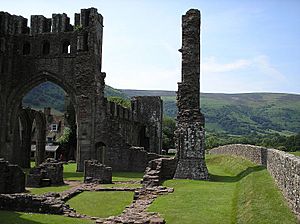Llanthony Priory facts for kids
Quick facts for kids Llanthony Priory |
|
|---|---|
 |
|
| Location | Llanthony, Monmouthshire, Wales |
| Governing body | Cadw |
| Lua error in Module:Location_map at line 420: attempt to index field 'wikibase' (a nil value). | |
Llanthony Priory is a partly ruined former Augustinian priory. It is located in the quiet Vale of Ewyas, a valley within the Black Mountains. This area is part of the Brecon Beacons National Park in south east Wales.
The priory is about seven miles north of Abergavenny. It sits on an old road that leads to Hay-on-Wye in a place called Llanthony. The ruins are west of the Hatterrall Ridge, which is part of the Black Mountains. Cadw, a Welsh government body, looks after the main ruins, and you can visit them for free.
Llanthony Priory is a very important historical site. It is a Grade I listed building, meaning it has special historical interest. Other buildings nearby, like the Abbey Hotel, St David's Church, and Court Farm Barn, are also Grade I listed.
Contents
History of Llanthony Priory
How Llanthony Priory Started
The story of Llanthony Priory began around the year 1100. A nobleman from Normandy named Walter de Lacy found a ruined chapel here. It was dedicated to St. David, the patron saint of Wales. Walter de Lacy was inspired to live a life of prayer and study in this peaceful spot.
Soon, others joined him, including Ersinius, who used to be a chaplain to Queen Matilda. She was the wife of King Henry I. A church was built on the site and was dedicated to St John the Baptist. It was officially opened in 1108. By 1118, about 40 monks from England came to live here. They started a priory for Canons Regular, which was the first of its kind in Wales.
Challenges and Rebuilding
In 1135, the monks faced many attacks from the local Welsh people. Because of this, they moved to Gloucester and started a new priory called Llanthony Secunda.
However, around 1186, another member of the de Lacy family, Hugh, helped the priory. He used money from his lands in Ireland to rebuild the church. This work was finished by 1217. Letters from Pope Clement III also show that the priory received more gifts and money between 1185 and 1188.
Llanthony Priory became one of the most important medieval buildings in Wales. It was built in a mix of Norman and Gothic styles. More building work happened around 1325, including a new gatehouse. On April 4, 1327, King Edward II stayed at the priory. He was on his way to Berkeley Castle, where he later died.
The Priory's End
After a rebellion led by Owain Glyndŵr in the early 1400s, the priory was not doing well. In 1481, it officially joined with its sister priory in Gloucester. Then, after 1538, King Henry VIII closed both priories. This was part of his Dissolution of the Monasteries, when many monasteries across England and Wales were shut down.
Llanthony in Later Centuries
After the priory closed, its buildings slowly fell into ruin. In the early 1700s, the old infirmary (a place for the sick) was turned into the Church of St David. In 1799, Colonel Sir Mark Wood bought the estate. He changed some of the buildings into a house.
In 1807, the famous poet Walter Savage Landor bought the estate. He wanted to be a country gentleman. He planted many trees and brought sheep from Spain. There is still a group of trees called "Landor's Larches" from his time.

Landor wrote about the beautiful valley to his friend Robert Southey. However, Landor faced many problems with his neighbours and tenants. He spent a lot of money trying to improve the land. Eventually, he left Llanthony and gave up the estate. Many of the buildings continued to fall apart after he left.
In 1869, a man known as Father Ignatius started an Anglican monastery nearby. He called it Llanthony Abbey. It lasted until 1908. Later, the artist Eric Gill lived in its buildings.
Llanthony Today
Over the years, the ruins have attracted many artists, including J. M. W. Turner. He painted the priory from a nearby hillside. In the 20th century, the Knight family bought the priory.
The house that Colonel Sir Mark Wood built later became the Abbey Hotel. The remaining ruins are protected by Cadw. You can visit them for free and explore this amazing historical site.
Walking Paths Around Llanthony
The Offa's Dyke Path is a famous walking trail. It runs close to the priory on the Hatterrall Ridge above the Llanthony Valley. This ridge also marks the border between Wales and England.
There are many footpaths that start from the large car park at the priory. You can walk up to the Hatterall Ridge. It is possible to do circular walks that take you to the ridge and back. These paths offer great views of the priory and the surrounding Black Mountains.
Images for kids









